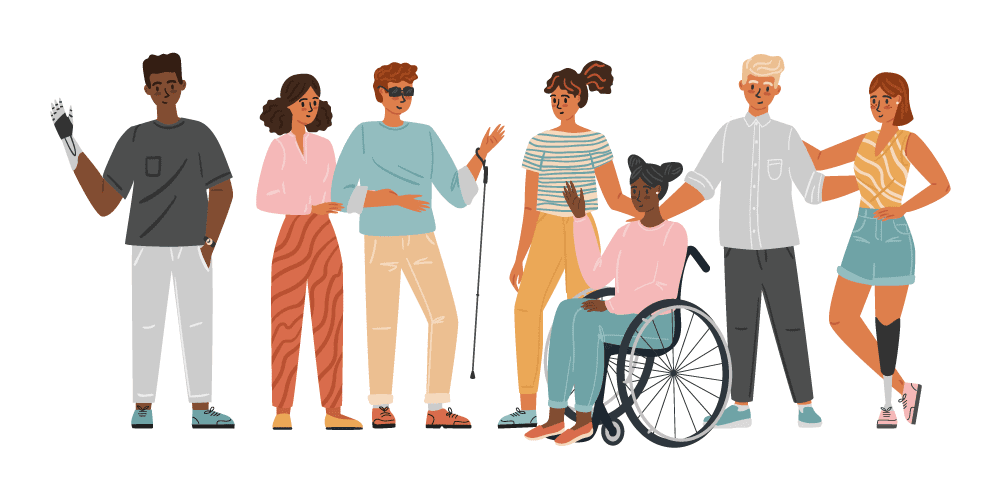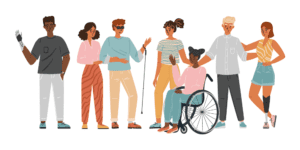Designing for Inclusion: Tips for Accessibility and User Experience

by Jai Djwa
 When we think of accessibility, we often think of people with visible disabilities. For example, folks with observable markers of disability, such as vision impairment or mobility issues. While this is important, I prefer to think of inclusion rather than access. Inclusion is a broader term that can also include folks with non-visible disabilities and other unique ways of representing the full range of human experience.
When we think of accessibility, we often think of people with visible disabilities. For example, folks with observable markers of disability, such as vision impairment or mobility issues. While this is important, I prefer to think of inclusion rather than access. Inclusion is a broader term that can also include folks with non-visible disabilities and other unique ways of representing the full range of human experience.
“Inclusive design describes methodologies to create products that understand and enable people of all backgrounds and abilities. Inclusive design may address accessibility, age, culture, economic situation, education, gender, geographic location, language, and race. The focus is on fulfilling as many user needs as possible, not just as many users as possible.” (NN Group)
As Alison Shaw points out, “We are all only temporarily abled.” Which is true for me as I wear glasses, and if I don’t have them, my sight is very poor. Or maybe someone breaks their arm or is holding a bag of groceries or a baby. The user experience is the same for them as someone who lost their arm due to an injury.
There are lots of authors that cover this in greater detail, such as Kat Holmes pioneering work at Microsoft (check out her medium) and Laura Kalbag’s book Accessibility for Everyone.
So it’s key that we consider inclusion in our design. Here are some fast tips on how to do this.
Design for everyone
Kat Holmes talks about “Solve for one, extend to many.” It’s her idea that a design idea can be helpful to more than just one person. For example, closed captioning can be helpful for people in a place where they can’t hear the sound, someone learning English, or even a child learning to read. You design for one person, like someone deaf, and then ask who else might be excluded in a different context, like the person in an airport.
Design mobile-first
Inclusive design is mobile-first. So many folks with disabilities are accessing websites from their mobile phones. In fact, like designing for everyone, accessing websites on a mobile phone is huge. Over 60% of global web traffic is from mobile phones.
By designing mobile-first, a designer has to focus on prioritizing information in a tiny screen and also ensure a touch driven environment. These are useful for building up inclusive design.
Make content easy to read
Plain language is another key technique for inclusive design. Plain language is a methodology used by my clients in public legal education to make complicated legal standards easy to understand. But it’s a format that can help anyone as it is the idea that writing should be straightforward and avoid complicated sentences and words. This approach also helps anyone reading on the web as the skimming of content by a user is commonplace.
And ensuring that images have ALT text and videos have captions and transcripts is also important. I fall down on ALT text, so I know that is an area I have to work on.
Use keyboard navigation
For folks with mobility issues, keyboard navigation is important. I’ve tried navigating websites with just a keyboard and it is painful. VoiceOver from Apple is built-in to all Apple devices, including iPhone, but takes a lot of getting used to. Tab hierarchy becomes critical and so many websites have a poor experience. (Try Google’s ChromeLens for insight on this!)
Yet keyboard navigation is critical for screen readers that are used by folks that are blind or have limited vision and those that have hand mobility issues.
Overall, as designers, it’s critical to consider inclusion and accessibility in design, whether it’s for people with visible or non-visible disabilities. Good user experience is the same for all, but we as designers can think additionally about designing for everyone, designing mobile-first, using plain language, and enabling keyboard navigation. By taking more of an inclusive design approach, we ensure that a broader range of users can access our digital designs and do so with ease!
Recommended Posts

Harnessing the Power of UX in the Physical World
January 12, 2023

User Testing in Communities of Colour
December 19, 2022
